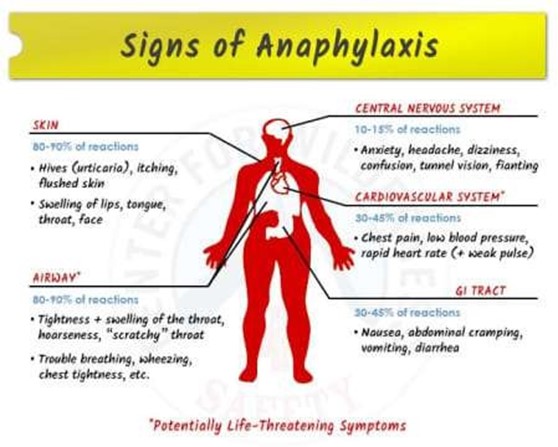A nurse is caring for a client who is receiving ceftriaxone intravenously.
Which of the following manifestations should the nurse identify as an allergic reaction?
Polyuria.
Hypotension.
Nausea.
Bradycardia.
The Correct Answer is B
This is because hypotension (low blood pressure) can be a sign of anaphylaxis, which is a severe allergic reaction that can occur with ceftriaxone.

Choice A is wrong because polyuria (increased urination) is not a common sign of an allergic reaction to ceftriaxone.
Choice C is wrong because nausea can be a side effect of ceftriaxone but is not specific to an allergic reaction.
Choice D is wrong because bradycardia (slow heart rate) is not a common sign of an allergic reaction to ceftriaxone.
Nursing Test Bank
Naxlex Comprehensive Predictor Exams
Related Questions
Correct Answer is A
Explanation
Choice A rationale: Administering filgrastim after chemotherapy is a standard practice to boost white blood cell count. However, filgrastim should not be given within 24 hours before or after chemotherapy, as it can affect the efficacy and increase the risk of side effects. Administering the medication 12 hours after chemotherapy falls within this contraindicated window, necessitating an incident report.
Choice B rationale: Filgrastim can be stored at room temperature for short periods, and 2 hours is generally within acceptable limits for stability.
Choice C rationale: An absolute neutrophil count of 2,500/mm³ is within the normal range, and there is no contraindication for administering filgrastim.
Choice D rationale: Flushing the client's IV line with dextrose 5% in water before and after administering filgrastim is not appropriate, as this medication is typically administered with saline solution. Using an incorrect flushing solution could affect the medication's efficacy or compatibility, necessitating an incident report.
Correct Answer is C
Explanation

Fentanyl buccal film is a small film that sticks to the inside of the cheek and eventually dissolves within 15 to 30 minutes after it is applied.
It is used to manage breakthrough pain in patients with cancer who are already using another opioid pain medicine around-the-clock.
Choice A is wrong because the medication should not be placed on the client’s tongue for dissolution.
Choice B is wrong because the medication should not be dissolved in water before administering it.
Choice D is wrong because the client should not be instructed to swallow the medication with a sip of water.
Whether you are a student looking to ace your exams or a practicing nurse seeking to enhance your expertise , our nursing education contents will empower you with the confidence and competence to make a difference in the lives of patients and become a respected leader in the healthcare field.
Visit Naxlex, invest in your future and unlock endless possibilities with our unparalleled nursing education contents today
Report Wrong Answer on the Current Question
Do you disagree with the answer? If yes, what is your expected answer? Explain.
Kindly be descriptive with the issue you are facing.
